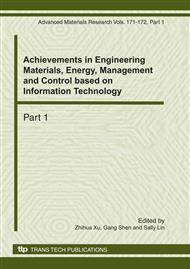[1]
J. GUO Bing, SHEN Yan, GUO Zi-li. The Redefinition and Some Discussion of Green Computing CHINESE JOURNAL OF COMPUTERS, Vol. 32 No. 12 Dec 2009: 2313, 2316-2317.
Google Scholar
[2]
J. GUO Min-yi. Green Computing: Connotation and Tendency Computer Engineering, Vol. 36 No. 10 May 2010: 1-2.
Google Scholar
[3]
M. SHAN Yong-Kui. Assessment Principles for Green ChemistryBeijing: China Petrochemical Press, (2006).
Google Scholar
[4]
C. CHEN Huacai, JIN Hai, SHAO Zhiyuan, et al. ClientVisor: Leverage COTS OS Functionalities for Power Management in VirtualizedDesktop Environment /Proc. of 2009 ACM IGPLAN/SIGOPSInternational Conf. on Virtual Execution Environments. New York, USA: ACM Press, (2009).
DOI: 10.1145/1508293.1508312
Google Scholar
[5]
Wang David. Meeting green computing challenges/Proceed-ing of HDP'07. Shanghai, China, 2007: 87-88.
Google Scholar
[6]
Z. Electronic Product Environmental Assessment Tool(EPEAT) [2010-04-01]. http: /www. epeat. net.
Google Scholar
[7]
Francis Kevin, Richardson Peter. Green Maturity Model forVirtualization. Issue 18-Green Computing, The ArchitectureJournal, http: /www. architecturejournal. net, (2009).
Google Scholar
[8]
C. Andersen D G, Franklin J, Kaminsky M, et al. FAWN: A Fast Arrayof Wimpy Nodes/Proc. of SOSP'09. Big Sky, Montana, USA: ACM Press, (2009).
Google Scholar
[9]
Shao Z. High performance, low power and secure embeddedsystems [Ph. D. dissertation]. School of Engineering andComputer Science, University of Texas at Dallas, Dallas, (2005).
Google Scholar
[10]
C. Bui V, Norris B, Huck K, et al. A Component Infrastructure forPerformance and Power Modeling of Parallel Scientific Appli-cations/Proc. of CBHPC'08. Karlsruhe, Germany: [s. n. ], (2008).
Google Scholar


